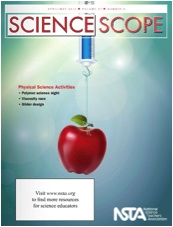Physical science activities
By Mary Bigelow
Posted on 2014-04-27
 Middle schoolers enjoy a challenge. The featured articles in this issue show that incorporating physical science concepts with engineering practices and crosscutting concepts can lead to challenging projects for students (and their teachers as they choose and develop activities aligned with the NGSS).
Middle schoolers enjoy a challenge. The featured articles in this issue show that incorporating physical science concepts with engineering practices and crosscutting concepts can lead to challenging projects for students (and their teachers as they choose and develop activities aligned with the NGSS).
As budgets for equipment and supplies shrink, it’s interesting to read articles such as Straws and Air Pressure: Using an Everyday Object to Explain Air Pressure that show how simple materials can be used to demonstrate and investigate complex phenomena. The author used a learning cycle model that included opportunities for students to investigate air pressure and the discoveries of Bernoulli, Charles, and Boyle through exploration, invention, and application. She suggests strategies that students can use in these investigations with straws, plastic cups, and pins. [SciLinks: Bernoulli’s Principle, Gas Laws]
Are you trying to simulate real-world experiences for your students? Collaboration is a lifetime skill, and much collaboration today occurs electronically. Ring the Bell: An Asynchronous Learning Experience discusses a capstone project in which students designed a Rube Goldberg machine, working with team members who were not in their class period. They worked with each other electronically and through a group notebook until the day they met to build their machine. The authors include several resources for adapting this idea to your classes, including the logistics and a description of the design task. If more than one science teacher is involved, teacher collaboration is critical to the success of the project. [SciLinks: Simple Machines]
Some family night or open house events wow the parents and students with flashy gee-whiz demonstrations. I often wondered what the participants learned from them. But Polymer Science Night: The Science Behind the Fun used a study of polymers in the context of local manufacturing and design companies. The authors include a brief primer on polymers, describe the activities the students and parents did, and provide many good suggestions for Family Night events related to any topic. [SciLinks: Polymers]
The Great Viscosity Race: Using the 5E Model to Make Connections Between Properties of Matter and Viscosity has ideas for students to investigate why liquids flow at different rates. What they learn can be applied to studying the flow rates of lava, for example. The author suggests how to structure the activity so that students design the procedure and make the connections to lava flows. [SciLinks: Density, Magma/Lava]
The Great Iced Tea Debate takes on the question “What is the best way to sweeten tea?” and challenges students to apply their learning about density, solubility, and properties of matter and let “data do the talking.” The authors include a planning template that could be adapted for any student-designed investigation. As I read the article, written in a conversational style, I could picture my own students’ questions. [SciLinks: Solubility, Properties of Liquids]
Rather than getting in trouble for flying paper planes, students can learn much about the principles of flight: If You Build It, Will It Fly? The students built a model to experiment with, collected data and then designed their own to test. [SciLinks: Forces of Flight, Newton’s Laws]
Disclaimer: The views expressed in this blog post are those of the author(s) and do not necessarily reflect the official position of the National Science Teaching Association (NSTA).


